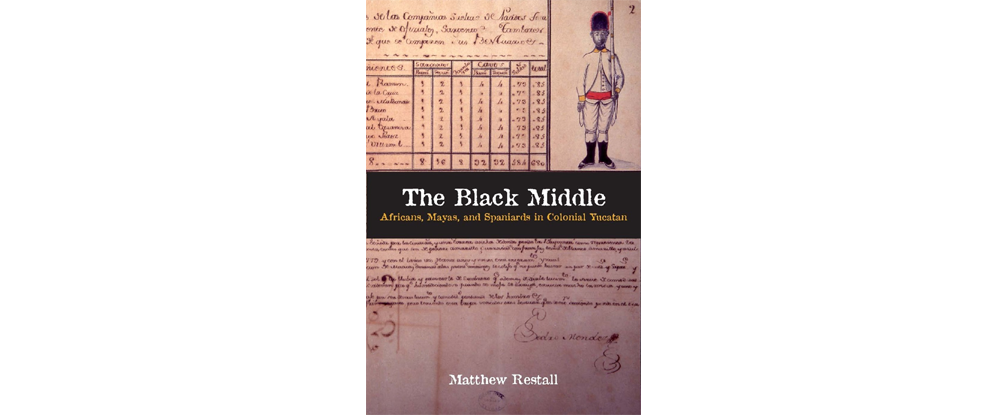(NOTE: The following is the frontispiece of an important book for Belizeans to read. The book is called THE BLACK MIDDLE: Africans, Mayas, and Spaniards in Colonial Yucatan. The book is written by Matthew Restall, who is Professor of Latin American History and Director of Latin American Studies at Pennsylvania State University.)
THE BLACK MIDDLE is the first full-length study of black African slaves and other people of African descent in the Spanish colonial province of Yucatan, which is today part of southern Mexico.
The study is based on Spanish and Maya language documents from the sixteenth through the nineteenth centuries found in a dozen different archives (mostly in Spain and Mexico).
Restall’s goal is to discover what life was like for a people hitherto ignored by historians. He explores such topics as slavery and freedom, militia service and family life, bigamy and witchcraft, and the ways in which Afro Yucatecans (as he dubs them) interacted with Mayas and Spaniards.
He concludes that in numerous ways Afro Yucatecans lived and worked in a middle space between—but closely connected to — Mayas and Spaniards. The book’s “black middle” thesis has profound implications for the study of Africans throughout the Americas.
(NOTE: Here is a sample of Restall’s work, taken from pages 148 and 149 of the book, published in 2009 by Stanford University Press.)
“San Fernando Ake was founded in 1796 by the colonial authorities as a settlement for Afro-Haitian soldiers who had fought for Spain in the wars over Sainte Domingue and Santo Domingo. The original 115 settlers were set up in a plaza within the abandoned Maya site of Ake, their community dubbed San Francisco de los Negros and constituted as an official PUEBLO of militiamen. Within a decade, the village had doubled in size as its leaders admitted free-colored migrants. But there was also a gradual process of Mayanization, whose mechanisms were settlement patterns and—most importantly—how they made a living.
“Inevitably many of the militiamen took Maya wives. They also took up the occupations of their in-laws, most notably cattle ranching, corn farming, hunting, and beekeeping. There were already some Mayas living in the pueblo by 1806; in 1826, a quest for ‘deserters’ revealed that a number of black militiamen had simply settled in the Maya villages adjacent to their cornfields; by 1840 San Fernando was 40% Maya. “Ake was chosen for its location near the vulnerable north coast of the colony, and so there were militia units of Afro-Yucatecans already living in the area. These militiamen, their families, and descendants lived in various pueblos north of Valladolid, most notably Tizimin (which was 27% Afro-Yucatecan by 1813), but only in one parish — that of Kikil—did they become a slim majority by the end of the eighteenth century. Back in 1688, there were only a dozen non-Maya adults in Kikil, and a similar number in its neighboring villages; the area was just a few per-cent Afro-Yucatecan. In 1757 Bishop Padilla noted that Kikil had over two hundred residents ‘of all mixes (DE TODA MEZCLA).’ Baptism and burial records show that by the 1790s the communities of Kikil parish were over a fifth Afro-Yucatecan. The census of 1806 categorizes the parish’s 2,143 residents as 9% Spanish, 10% mestizo, 47% Maya, and 34% pardo. But a breakdown of communities within the parish reveals a more complex pattern. As the first Afro-Yucatecan population expanded in the four villages (Kikil itself and its subject hamlets of Loche, Panaba, and Sucila), a push-pull factor effectively pushed Mayas out of those villages while at the same time wage labor pulled them into the local haciendas. Thus in 1806 the working population on the haciendas was all Maya, while in the villages Afro-Yucatecans were on average a slim majority; Sucila was 72% pardo. The census did not record occupations, but it is reasonable to assume that, in addition to militia wages, the pardo families of Kikil sustained themselves with the same agricultural pursuits that supported the black, free-colored, and Maya families of San Fernando Ake and its environs. In other words, as Kikil became more Afro-Yucatecan in demographic terms, its pardo residents became more Maya in occupational terms.”

